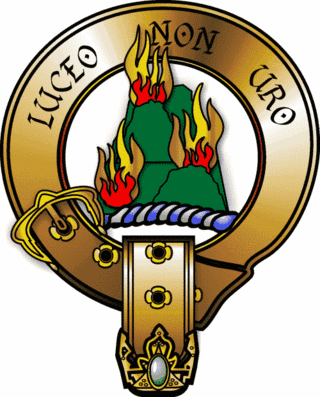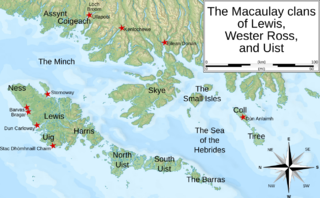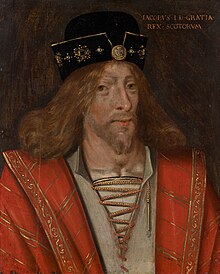
Eilean Donan is a small tidal island situated at the confluence of three sea lochs in the western Highlands of Scotland, about 1 kilometre from the village of Dornie. It is connected to the mainland by a footbridge that was installed early in the 20th century and is dominated by a picturesque castle that frequently appears in photographs, film and television. The island's original castle was built in the thirteenth century; it became a stronghold of the Clan Mackenzie and their allies, the Clan MacRae. In response to the Mackenzies' involvement in the Jacobite rebellions early in the 18th century, government ships destroyed the castle in 1719. The present-day castle is Lieutenant-Colonel John Macrae-Gilstrap's 20th-century reconstruction of the old castle.

Clan Mackenzie is a Scottish clan, traditionally associated with Kintail and lands in Ross-shire in the Scottish Highlands. Traditional genealogies trace the ancestors of the Mackenzie chiefs to the 12th century. However, the earliest Mackenzie chief recorded by contemporary evidence is Alexander Mackenzie of Kintail who died some time after 1471. Traditionally, during the Wars of Scottish Independence, the Mackenzies supported Robert the Bruce, but feuded with the Earls of Ross in the latter part of the 14th century. During the 15th and 16th-centuries the Mackenzies feuded with the neighboring clans of Munro and MacDonald. In the 17th century the Mackenzie chief was made Earl of Seaforth in the peerage of Scotland. During the Scottish Civil War of the 17th century the Mackenzies largely supported the Royalists. During the Jacobite rising of 1715 the chief and clan of Mackenzie supported the Jacobite cause. However, during the Jacobite rising of 1745 the clan was divided with the chief, Kenneth Mackenzie, Lord Fortrose, supporting the British-Hanoverian Government and his relative, George Mackenzie, 3rd Earl of Cromartie, supporting the Jacobites.

The Clan Macrae is a Highland Scottish clan. The clan has no chief; it is therefore considered an armigerous clan.

Clan MacLennan, also known as Siol Ghillinnein, is a Highland Scottish clan which historically populated lands in the north-west of Scotland. The surname MacLennan in Scottish Gaelic is Mac Gille Fhinnein, meaning the son of the follower of St Finnan.

Clan Matheson is a Highland Scottish clan.

The Battle of Bealach nam Broig was fought between Scottish clans from the lands of north-west Ross, against north-eastern clans of Ross who supported the Earl of Ross. The actual date of the battle is debated, it probably occurred in 1452 but the Conflicts of the Clans suggests a date as early as 1299.

The Macaulay family of Uig in Lewis, known in Scottish Gaelic as Clann mhic Amhlaigh, were a small family located around Uig on the Isle of Lewis in the Outer Hebrides of Scotland. There is no connection between the Macaulays of Lewis and Clan MacAulay which was centred in the Loch Lomond area, bordering the Scottish Highlands and Scottish Lowlands. The Macaulays of Lewis are generally said to be of Norse origin because of the etymology of their surname and also because of the islands' Viking Age past. However, a recent analysis of the Y-DNA of men with Scottish surnames has shown that a large number of Hebridean Macaulays are of Irish origin. In the 17th century, however, tradition gave the Macaulays an Irish origin. By the end of the 16th century the dominant clan on Lewis was Clan Macleod of The Lewes. Other notable Lewis clans were the somewhat smaller Morrisons of Ness and the even less numerous Macaulays of Uig. The Macaulays were centred in the area surrounding Uig on the western coast of Lewis, and had a deadly, long-standing feud with the Morrisons, whose lands were located on the northern coast around Ness. Today the Lewis surname Macaulay is considered to be a sept name of the Macleods of Lewis. There are two other nearby clans of Macaulays who may, or may not, be connected to the Lewis clan—the Wester Ross Macaulays, and the Uist MacAulays.
Donnchadh MacRath, also known as Duncan MacRae of Inverinate and Donnchadh nam Pìos, was a Scottish Gaelic poet and the compiler of the Fernaig manuscript which he committed to paper using an English-influenced system of orthography.
Alexander Mackenzie, known as "Ionraic", traditionally counted as 6th of Kintail, was the first chief of the Clan Mackenzie of whom indisputable contemporary documentary evidence survives. During his long life, he greatly expanded his clan's territories and influence.
Hector Roy Mackenzie of Gairloch was a Scottish clan chieftain of the Clan Mackenzie, who acquired vast estates in and around Gairloch, Wester Ross as a result of his services to the Scottish crown and challenged his nephew for the chiefship of the clan.
Kenneth Mackenzie, was the 10th laird of Kintail and he was nicknamed Coinneach na Cuirc in Scottish Gaelic, was a Highland chief, head of the Clan Mackenzie, who flourished in the turbulent Scottish politics of the mid-16th century.
John Mackenzie, or "John of Killin", traditionally reckoned 9th of Kintail, was a Highland chief and head of the Clan Mackenzie.
Leod Macgilleandrais is purported to have been a 14th-century Scotsman who lived in the north-west of Scotland. He is known from clan traditions which date to the late 17th century. According to these traditions, Leod was a follower of the Earl of Ross, and that he was an enemy of the Mackenzies of Kintail. He is said to have captured one of the early Mackenzie chiefs, and was then later killed by the slain chief's son sometime in the 14th century. His memory is preserved in the place where he is said to have been slain. According to at least one version of the tradition, Leod was survived by a son named Paul. Several historians in 19th and early 20th centuries equated this son to Paul Mactire.
Kermac Macmaghan was a thirteenth-century Scottish nobleman. In 1262, he is stated to have aided William I, Earl of Ross in a particularly vicious attack in the Hebrides. The assault itself is recorded by a thirteenth-century Scandinavian saga, and was likely conducted on behalf of Alexander III, King of Scotland, who wished to incorporate Isles into the Scottish realm. The following year, Hákon Hákonarson, King of Norway launched an expedition into the Isles to reassert Norwegian authority. The latter's campaign proved to be an utter failure, and after his departure and death the same year, the Scots forced the submission of the leading magnates of the Isles. In 1264, Kermac is recorded to have received compensation for services rendered. A fifteenth-century pedigree concerning Clan Matheson seems to indicate that Kermac is identical to a certain Coinneach mac Mathghamhna, ancestor of the clan. The latter may or may not be an ancestor of Clan Mackenzie.
Lieutenant Colonel John MacRae-Gilstrap was a British army officer and a senior figure of the Clan Macrae. He contested a rival claim to the chiefship of the clan, and in 1912 he purchased and subsequently restored the Macrae stronghold of Eilean Donan Castle on Loch Duich in the west of Scotland.

Lochalsh is a district of mainland Scotland that is currently part of the Highland council area. The Lochalsh district covers all of the mainland either side of Loch Alsh - and of Loch Duich - between Loch Carron and Loch Hourn, ie. from Stromeferry in the north on Loch Carron down to Corran on Loch Hourn and as (south-)west as Kintail. It was sometimes more narrowly defined as just being the hilly peninsula that lies between Loch Carron and Loch Alsh. The main settlement is Kyle of Lochalsh, located at the entrance to Loch Alsh, opposite the village of Kyleakin on the adjacent island of Skye. A ferry used to connect the two settlements but was replaced by the Skye Bridge in 1995.
The Murchison family of Loch Alsh, Ross-shire, Scotland were a minor Scottish clan, and a sept of the larger Clan Mackenzie. In modern times the Murchison surname is still considered a sept of the Clan Mackenzie by the Clan Mackenzie Society of Scotland & the UK.
Farquhar Macrae (1580-1662) was a Scottish minister in the parishes of Gairloch and Kintail, Ross and Cromarty. He is known for the cultural improvement he brought to the north of Scotland in the seventeenth century.

The Battle of Drumchatt, or Druim-a-Chait, was a Scottish clan battle claimed by non-contemporary historians to have taken place in the year 1501 near Strathpeffer, in the Scottish Highlands. It was allegedly fought between the Clan Mackenzie and the Clan Munro. Mackenzie chronicles have claimed a signal victory.

Murdo or Murdoch Mackenzie, also known as Murdo McRorie was a Scottish courtier and the builder of Fairburn Tower near Inverness.












